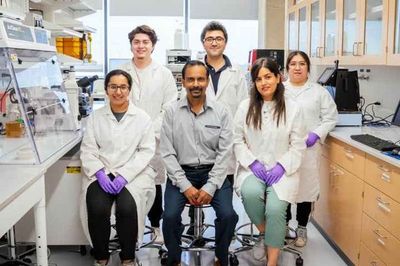seeing green
Houston team researching how algae can combat climate change

Venkatesh Balan and his team at UH are researching ways fresh- and salt-water phototropic organisms, or microalge, can sequester carbon from industrial refineries and convert it into useful byproducts. Photo via UH.edu
Researchers at the University of Houston are looking at an alternative way to capture carbon that uses a surprising conduit: algae.
In a newly published article in Green Chemistry, a journal of the Royal Society of Chemistry, Venkatesh Balan, associate professor of engineering technology at UH, details how he and his team are researching ways fresh- and salt-water phototropic organisms, or microalgae, can sequester carbon from industrial refineries and convert it into useful byproducts.
Balan is joined by UH researchers James Pierson and Hasan Husain, Sandeep Kimar from Old Dominion University, Christopher Saffron of Michigan State University, and Vinod Kumar from Cranfield University in the United Kingdom.
According to a release from UH, Balan and research assistant Masha Alian have uncovered how microalgae can produce fungus like lichen and create healthy food products. After microalge captures the carbon, it then converts that CO2 into mass-produced proteins, lipids and carbohydrates, according to the team's research.
“We are coming up with the alternate approach of using algae to fix the CO2 then using the carbon to make bioproducts that are useful to mankind,” Balan said in the release.
The method offers an alternative to other carbon capture options that aim to burry carbon, which is expensive and energy intensive, according to UH.
Balan says this research also has applications in wastewater treatment and the production of food, fertilizers, fuels and chemicals, all of which could lessen the dependency on fossil fuels in the future.
"On your table or in your pantry, you see food products. What’s harder to visualize are the greenhouse gasses emitted by the orchard that grows the fruit, the factory that makes the breakfast cereal, the transportation that brings the cookies to your neighborhood, even your own commute to buy the food," Balan said. "It adds up, but the problem is easy to ignore because we can’t see it. Yet all consumers contribute, in our own way, to the greenhouse effect.”
The UH team is just one of many Houston groups looking at unconventional, although natural ways to combat climate change.
In September, Rice University announced that two researchers were awarded a three-year grant from the Department of Energy for their research into the processes that allow soil to store roughly three times as much carbon as organic matter compared to Earth's atmosphere.